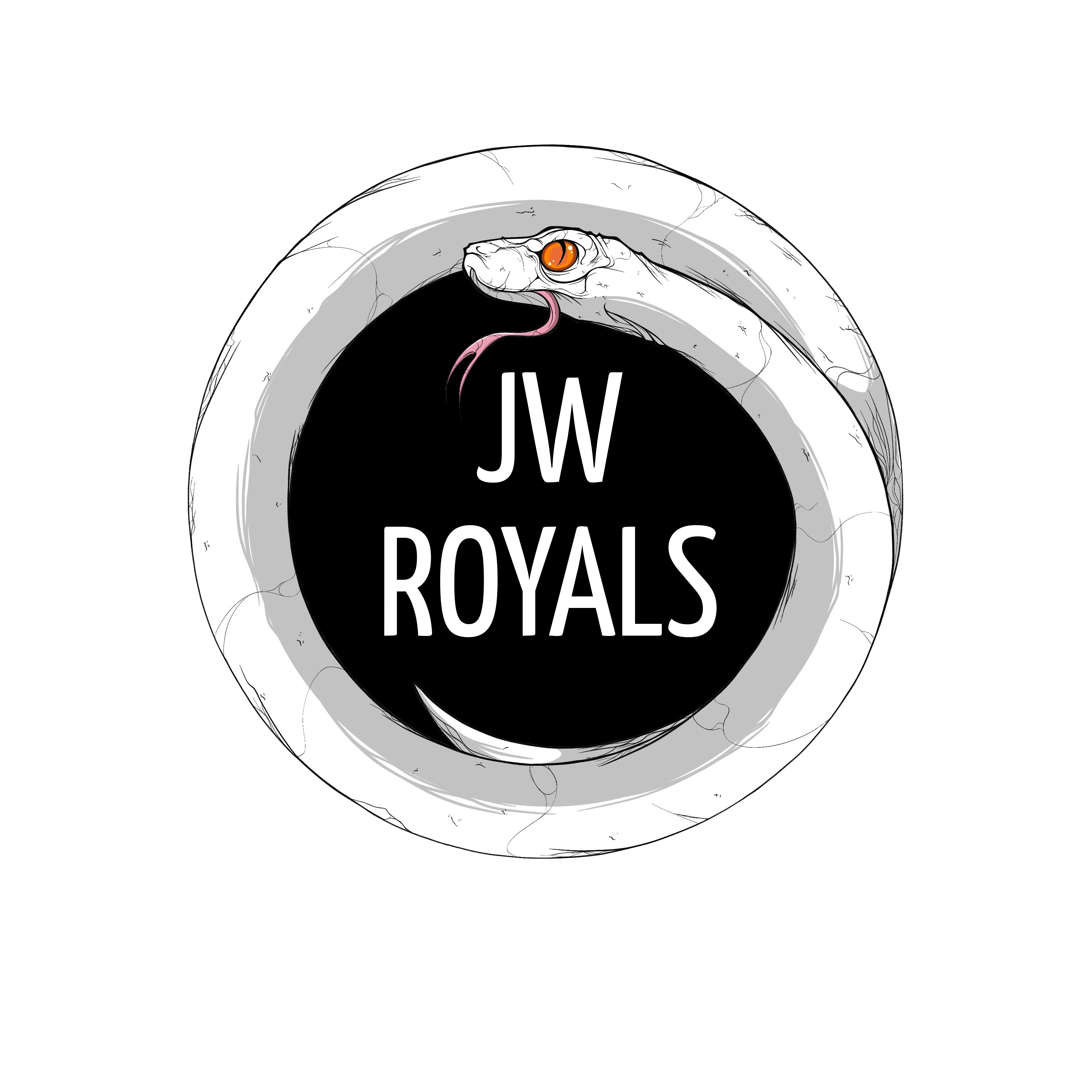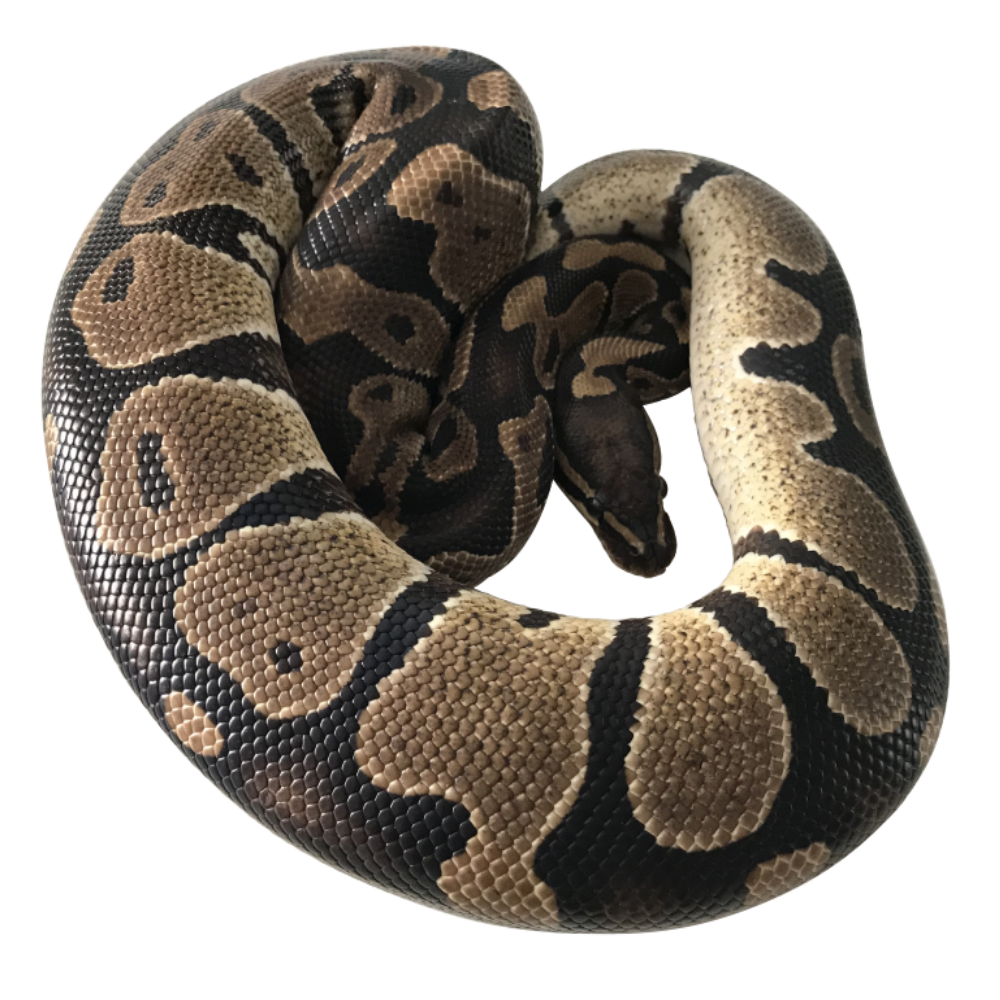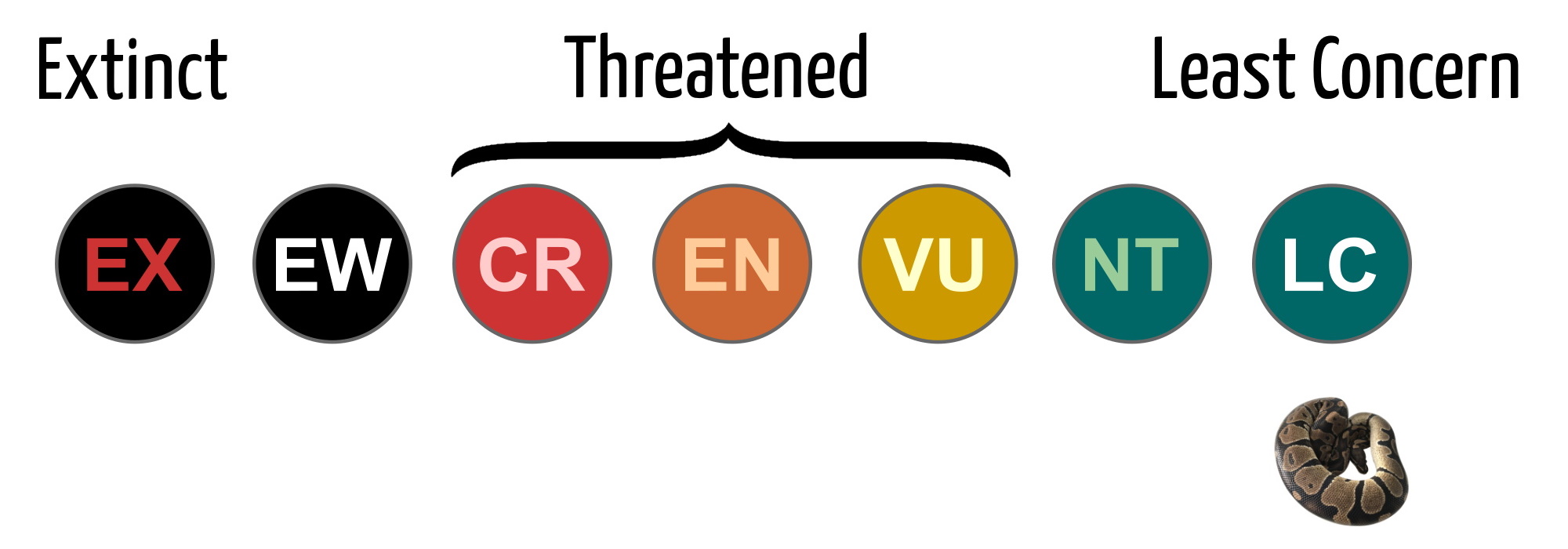Royal Python - Distribution & Habitat
The Royal Python aka Ball Python (Python Regius) is a species of python native to Central and Western Africa where it lives in a wide variety of habitats including grasslands, shrublands, open forestlands, mangrove swamps and savannahs. Royal Pythons are often found residing in termite mounds and mammal burrows, and are considered to be terrestrial, but upon inspection of wild specimens' stomach contents, specialists have discovered birds, bats and tree dwelling mammals which suggests that this species also exhibits arboreal behaviour.
The Royal Python has the largest and widest distribution of all species of snake with a range of 3500+ miles East - West and 500+ miles North - South. That's a total area of 1,750,000 mi². Ghana is the most associated country with the Royal Python as this was the first country to begin exporting this species around the world in the early 1990's.
Royal Python - Behaviour
Royal Pythons move by way of rectilinear locomotion, whereby bilateral symmetrical muscle contractions propel them forward as they push against the surface.
Royal Pythons are a carnivorous species and feed almost exclusively on terrestrial mammals such as African Soft Furred Rats and Grass Mice. Royal Pythons are sit-and-wait ambush predators, selecting a site to lie motionless waiting for an opportunity to strike and feed. Prey is then immobilised by constriction and swallowed whole.
Royal Python - Reproduction
Royal Pythons have long reproductive lives, starting at around 24 months to 25+ years of age. They breed once per year, and lay one clutch of eggs per year. Clutches can very from 1 - 16 eggs, 7 being the average yield. Once laid, the female will maternally incubate the eggs and remain coiled around them for about 60 days until they hatch. The females feed very infrequently whilst protecting the eggs.
Hatchlings are independent from the moment they hatch, but can remain in close proximity to the mother for a period of months.
Both male and female specimen breed with multiple partners every breeding season. Females can also retain sperm for over 12 months and use this to reproduce.
Royal Python - Physical Description
Hatchling Royal Pythons can be anywhere between 7.5" - 18" in length, growing to 4.5ft - 6ft as an adult. Sexual dimorphism isn't present in young specimen, and only becomes apparent at their adult size at around 4-5 years. Females tend to be larger in both length and width and can grow up to 5.5ft in length, however there have been reports of wild specimen reaching 6ft. Males often reach a maximum of 4.5ft - 5ft in length, and often have a more slender body shape.
The Royal Pythons typical appearance consists of large dark brown/black markings, with lighter brown/yellowish blotches stretching from the underbelly towards the spine. The underbelly is usually and off white/ivory colour. The head is generally dark with light lines stretching from the nostrils, through the eyes to the base of the head.
The Royal Python also possesses a pit organ which enable them to sense infrared thermal radiation. These pits are found on the nose, stretching around the sides of the face along the top jawline. These pits are around 2mm-4mm wide and deep, and have a pink fleshy appearance.
Royal Pythons also have pelvic spurs which are the vestigial remnants of rear legs. These spurs are located at either side of the cloaca (ventral scale). These spurs are often longer and more prominent in male specimen.
Royal Python - Predation
Royal Pythons use camouflage to avoid detection. When threatened, Royal Pythons often curl into a ball, positioning their head in the centre for protection. Other defensive actions include hissing, striking, biting and fleeing. Adult Royal Pythons actually have very few natural predators, however reports suggest that the Black Cobra (Naja Nigricollis) do prey on hatchlings and smaller specimens. Some known predators include carnivorous mammals and birds of prey, but again, hatchlings and smaller specimens are most at risk. Humans offered the largest threat in the 1990's exporting large numbers of wild caught specimen to Europe and North America.
Royal Python - Conservation Status
The IUCN does not consider the Royal Python to be endangered at present. It is listed under Appendix II of CITES in an effort to regulate trade in the species.
IUCN Red List: Least Concern
US Federal List: No Special Status
CITES: No Special Status
Royal Python - Scientific Classification
Kingdom: Animalia
Phylum: Chordata
Class: Reptilia
Order: Squamata
Suborder: Serpentenes
Family: Pythonidae
Genus: Python
Species: Python Regius
Common Name(s): Royal Python, Ball Python
References
Aubret, F., X. Bonnet, M. Harris, S. Maumelat. 2005. Sex Differences in Body Size and Ectoparasite Load in the Ball Python, Python regius.. Journal of Herpetology, 39/2: 312-215.
Aubret, F., X. Bonnter, R. Shine, S. Maumelat. 2002. Clutch size manipulation, hatching success and offspring phenotype in the ball python ( Python regius ). Biological Journal of the Linnean Society, 78: 263–272.
Bartlett, P., E. Wagner. 1997. Pythons: everything about selection, care, nutrition, diseases, breeding. Hauppauge, New York: Barrons Educational series.
Bartlett, P., B. Griswold, R. Bartlett. 2001. Reptiles, amphibians, and invertebrates: an identification and care guide. Hauppauge, New York: Barrons Educational series.
Bartlett, R., P. Bartlett. 2000. Ball Pythons. Hauppauge, New York: Barrons Educational series.
Bustard, H. 1969. Defensive Behavior and Locomotion of the Pacific Boa, Candoia aspera, with a Brief Review of Head Concealment in Snakes. Herpetologica, 25/3: 164-170.
De Vosjoli, P., R. Klingenberg, T. Barker, D. Barker. 1995. Ball Python Manual. Santee, California: Advanced Vivarium Systems.
Doeden, M. 2005. Pythons. Mankato, Minnesota: Capstone Press.
Ellis, T., M. Chappell. 1986. Metabolism, temperature relations, maternal behavior, and reproductive energetics in the ball python (Pythonregius). Journal of Comparative Physiology B, 157/3: 393-403.
Greene, H. 1997. Snakes: The Evolution of Mystery and Nature. Berkeley, California: Berkley University of California Press.
Luiselli, L., F. Angelici. 1998. Sexual size dimorphism and natural history traits are correlated with intersexual dietary divergence in royal pythons (Python regius) from the rainforests of southeastern Nigeria. Italian Journal of Zoology, 65/2: 183-185.
Luiselli, L. 2006. Why do males and females of Python regius differ in ectoparasite load?. Amphibia-Reptilia, 27/3: 469-471.
Mary Ann, M. 1996. Pythons. Minneapolis, MN: Capstone Press.
Mattison, C. 1986. Snakes of the World. New York, New York: Fact on File Publications.
McDonald, M. 1996. Pythons. Minneapolis: Capston Press.
Mukhtar, M., Y. Une, H. Kawabata, A. Takano, H. Sato, H. Watanabe. 2009. Trypanosoma cf. varani in an Imported Ball Python (Python reginus) From Ghana. The Journal of Parasitology, 95/4: 1029-1033.
O'Shea, M. 2007. Boas and Pythons of the World. London: New Holland Publishers.
Ott, B., S. Secor. 2007. Adaptive regulation of digestive performance in the genus Python. Journal of Experimental Biology, 210: 340-356.
Parker, H. 1963. Snakes of the World. New York: Dover Publications.
Platt, T., A. Bush. 1979. Spinicauda regiensis n. sp. (Nematoda: Heterakoidea), a parasite of the ball python ( Python regius).. Journal of Helminthology, 53/3: 257-260.
Seigel, R., J. Collins, S. Novak. 1987. Snakes-- ecology and evolutionary biology. New York, New York: Macmillan Publishing Co..
Sillman, A., J. Carver, E. Loew. 1999. The photoreceptors and visual pigments in the retina of a boid snake, the ball python (Python regius). Journal of Experimental Biology, 202/14: 1931-1938.
Sloboda, M., M. Kamler, J. Bulantova, J. Votypka, D. Modry. 2007. A New Species of Hepatozoon (Apicomplexa: Adeleorina) from Python regius (Serpentes: Pythonidae) and Its Experimental Transmission by a Mosquito Vector. The Journal of Parasitology, 93/5: 1189-1198.
Starck, J., P. Moser, R. Werner, P. Linke. 2004. Pythons metabolize prey to fuel the response to feeding. The Royal Society, 271/1542: 903-908.
Wright, A., A. Wright. 1957. Handbook of Snakes. Ithaca, New York: Comstock Publishing Associates.



